Minneapolis: The US city reclaiming its Native roots
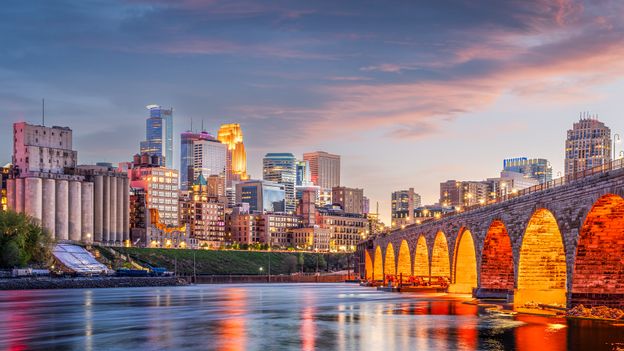
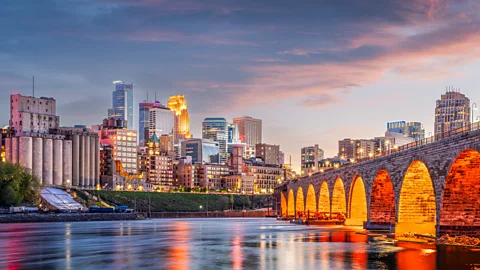 Getty Images
Getty ImagesAfter spearheading the modern fight for Native American rights, Minneapolis and nearby Saint Paul are experiencing an Indigenous cultural renaissance.
South of the Twin Cities of Minneapolis and Saint Paul, the confluence of the Minnesota and Mississippi rivers (known as Bdote, or “the place where the two rivers meet”), has been the most sacred site for the Indigenous Dakota people who have called this part of Minnesota home for thousands of years.
“Bdote is considered to be the centre of the Earth and the birthplace of the Dakota people,” said Eden Bart, of the Minnesota Humanities Center. Yet, it also marks the site of one of the most tragic historical events for the area’s Native residents.
In 1862, facing starvation and displacement by white settlers, a group of Dakota attacked white settlements, setting off a five-week war that led the US government to exile the Dakota from their ancestral homeland and forcibly relocate them to reservations in the Dakotas and Nebraska. That winter, the Dakota were kept in concentration camps at Bdote guarded by US troops while waiting for the river to thaw so they could be sent away on boats. The sacred site soon became a mass grave, as 38 Dakota men were hung in a mass execution on 26 December and hundreds of people died from disease and malnutrition during the winter.
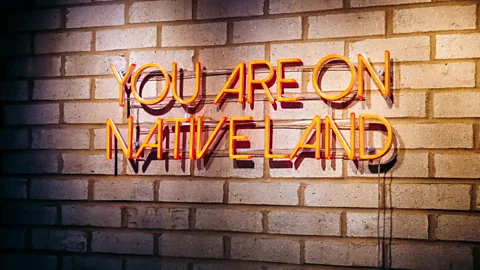 Alicia Erickson
Alicia EricksonNearly a century later, following the Indian Relocation Act of 1956 in which Native Americans were incentivised by the US government to relocate from reservations to cities, many Dakota began returning to the area. Now, more than 50 years after activists in Minneapolis spearheaded the modern fight for Native American rights, the Twin Cities are experiencing something of an Indigenous cultural renaissance and are one of the best places to explore modern Native culture in the US today.
This cultural revival was inspired by decades of discrimination following the Relocation Act. Mike Forcia, a member of the Bad River Band of Lake Superior Chippewa, remembers moving with his family to inner-city Saint Paul in 1969. Over the next decade, his family moved back and forth between Saint Paul and the reservation, as his father struggled to hold a stable job. “As I grew up, I realised many families bounced around and it was not just our family that couldn’t make it,” he said. “We were told we were free and to assimilate. That was so hard for some of our people, and many turned to drugs and alcohol.”
Rediscovering America
Rediscovering America is a BBC Travel series that tells the inspiring stories of forgotten, overlooked or misunderstood aspects of the US, flipping the script on familiar history, cultures and communities.
In addition to the personal trauma and struggle to find footing off the reservation, Indigenous communities faced immense discrimination. “At the time, Minneapolis’ Franklin Avenue, which was the heart of the Indigenous community, was lined with bars,” said Forcia. “Police would come and line people up and fill cars with Natives. There were stories of people getting picked up, beaten and thrown by the river.”
In the summer of 1968, roughly 200 members of Minneapolis’ Indigenous community gathered to address the police brutality and racial profiling of Native Americans. It was the birth of the American Indian Movement (AIM), which became the driving force behind the modern Indigenous civil rights movement. “We decided we would no longer be pushed to the margins,” said Forcia, who now serves as AIM’s chairperson.
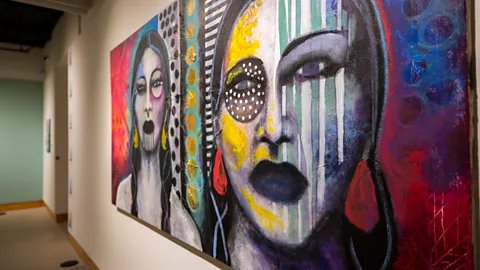 Jaida Grey Eagle
Jaida Grey EagleIn 1972, AIM representatives occupied the Bureau of Indian Affairs (BIA) in Washington DC as part of the Trail of Broken Treaties protests. AIM chapters spread across the US in the 1970s, and members organised protests, provided social services and advocated for the revival of cultural traditions.
Today, AIM still advocates for Native sovereignty from its Minneapolis headquarters, and prominent local leaders like Lieutenant Governor Peggy Flanagan (White Earth Band of Ojibwe) – the highest-ranking Native American woman elected to executive office in the US – are helping to protect and highlight Indigenous culture. Now, Native artists, chefs, authors, activists and community workers in the Twin Cities are creating spaces of healing, reconciliation and storytelling to restore ancestral traditions.
“We’re witnessing a Native awakening on a national scale, with unprecedented representation in realms from pop culture to politics,” noted Kate Nelson a local writer of Tlingit origin. “Amid this, Minneapolis has emerged as an epicentre for Indigenous creativity, from art to food to music and more.”
The heart of Minneapolis’ contemporary Indigenous community is Franklin Avenue East, where a veritable gallery of Native-designed street art is splashed across many of the area’s fading buildings. In the parking lot outside the Native American Community Development Institute, a mural by Native American artist Natchez Beaulieu shows Indigenous women celebrating under the night sky filled with constellations and the phases of the moon.
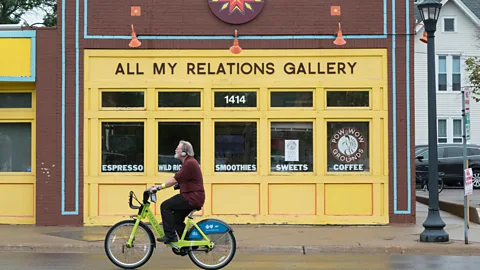 Getty Images
Getty ImagesIndigenous Minneapolis
The Bdote Memory Map is a great resource for visitors looking to explore Minneapolis’ Indigenous sites.
A few miles west in Minneapolis’ Kenwood Park neighbourhood, Birchbark Books is an indie bookstore opened by author Louise Erdrich, who hails from the Turtle Mountain Band of Chippewa, showcasing Native American authors. The store also sells beadwork and red willow baskets, among other crafts by local Indigenous artists, and periodically hosts special events and readings.
Elsewhere, Oglala Lakota Sioux chef and Minneapolis-area local Sean Sherman is one of the most prominent forces helping to revive Native food in the US. Growing up in South Dakota’s Pine Ridge Reservation with little access to Indigenous food, Sherman wanted to learn about and increase the visibility of Native cuisine. In 2015, he founded North American Traditional Indigenous Food Systems (NĀTIFS) to teach farming techniques and nutritional health to Indigenous communities before launching the Indigenous Food Lab. The kitchen and training centre is located in Minneapolis’ Midtown Global Market and serves salads, tacos and grain bowls topped with Indigenous staples like slow-cooked bison and the three sisters (corn, beans and squash).
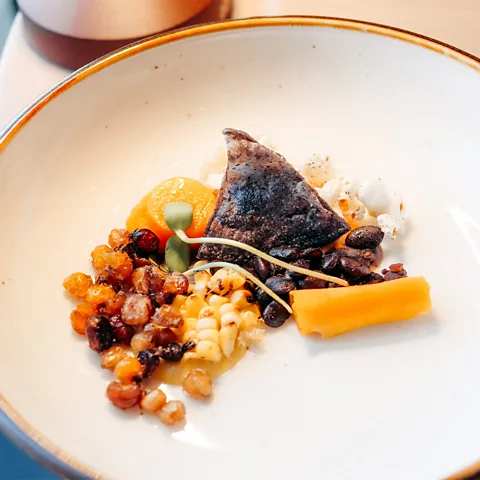 Alicia Erickson
Alicia EricksonFor a more immersive dining experience, book a table at Sherman’s restaurant, Owamni, which opened in downtown Minneapolis in 2021. A neon sign reading “You are on Native Land” greets you as you enter. While the menu shifts with the seasons, one thing remains unchanged: the food is a crucial history lesson, featuring exclusively pre-colonial ingredients with an emphasis on wild game and wild produce. Corn and beans, squash and maple syrup, elk and bison and wild rice and berries – among other ingredients – are crafted into mouthwatering dishes that reflect regional Indigenous traditions. “We envision a world where we see multiple Indigenous restaurants featuring true regional cultural and culinary diversity,” said Sherman.
Owamni overlooks a river of deep importance: Owámniyomni, (“turbulent waters” in Dakota), which has been a sacred site of Dakota rituals and treaties for thousands of years. In the early 1870s, a concrete apron was built on the falls that changed its natural flow and desecrated the land and islands around the river, including Wíta Wanáǧi, which was a sacred spot for Dakota women to give birth.
“Land and cultural restoration in Dakota are one and the same. Taking care of the land is our culture,” said Shelly Buck, Bdewakantunwan Dakota and president of Owámniyomni Okhódayapi, which aims to restore the falls. “Owámniyomni is our living relative. The water, the land, the birds are our relatives. Industrialisation destroyed the river, exploiting it as a commodity.”
Loosely translating to “Friends of the Falls” in Dakota, Owámniyomni Okhódayapi was formed in 2016 with the goal of restoring the land and eventually returning it to the Dakota. The vision is for Owámniyomni to be a place where Dakota culture and history can be celebrated. Currently, visitors can join a guided tour or take an independent walk along the river and follow interpretive signs describing the area’s historical and cultural significance in both Dakota and English.
 Getty Images
Getty ImagesTo dive deeper into Dakota history, join Learning From Place: Bdote for a tour led by Dakota guides who bring visitors to three places of Indigenous historical and spiritual significance. The morning starts at scenic Fort Snelling State Park in Saint Paul, where a drumming ceremony punctuates the chilling story of the concentration camps that once lined the Bdote. The tour then continues to the Indian Mounds Regional Park burial site and Oȟéyawahe/Pilot Knob Preservation Site, which was a sacred Dakota burial ground that has been preserved with natural grasses and trails. Public tours are offered several times per year, including as part of the Twin Cities’ annual Great Northern Festival (23 January to 2 February 2025).
As more galleries, restaurants and organisations honour the Twin Cities’ Indigenous past and present, a feeling of Native pride is blossoming after centuries of hardship.
“I encourage people to take the time to really engage with the Native history and culture of Minneapolis and Saint Paul, and to take in the fullness of Indigenous life here, with both its joys and traumas,” said Nelson.
Related
Canada says too little, too late as Trump flip-flops on…
Nadine Yousif and Ali Abbas AhmadiBBC News, TorontoWatch: Canadian liquor store clears out US alcohol in response to tariffsNot long after the US imposed their
Vietnam, Thailand, and Philippines Among Top Asian Destinations Most-Searched by…
Home » Philippines Travel News » Vietnam, Thailand, and Philippines Among Top Asian Destinations Most-Searched by American Travelers, Driven by Surge in Viet
Trump tariffs tarnish ties: Americans anxious about travel to Canada…
Will Trump's tariffs on Canadian goods entering the U.S. affect tourism at home, tarnishing ties Canadians and Americans have shared for decades? It's a fair qu
Looming Trump travel ban strikes fear in Afghans who worked…
Expectations that President Donald Trump will soon bar Afghans and Pakistanis from entering the United States has set off panic among Afghans who were promised












